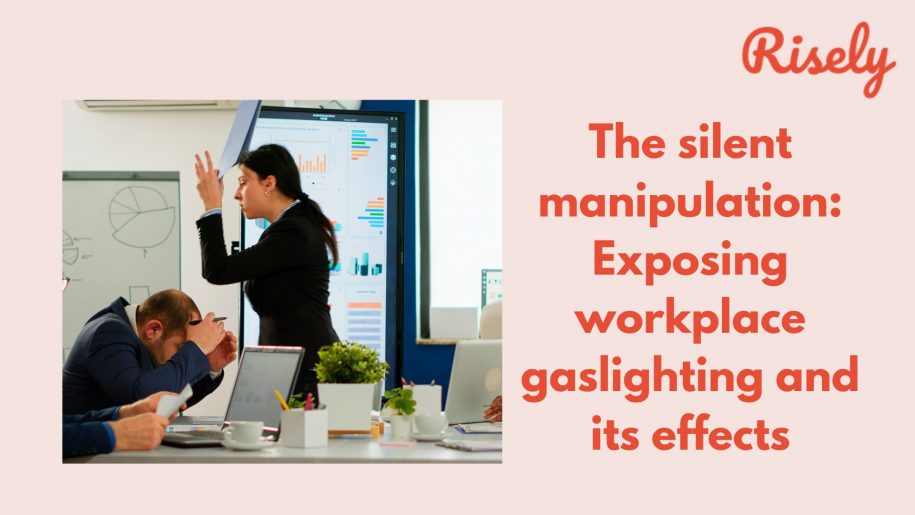The silent manipulation: Exposing workplace gaslighting and its effects
Employees strive to excel, collaborate, and contribute their best in today’s competitive work environments. However, while pursuing success, some individuals experience a toxic phenomenon known as workplace gaslighting. This subtle yet damaging form of manipulation can erode confidence, sow self-doubt, and hinder professional growth. In this blog, we explore the unsettling world of workplace gaslighting, shedding light on its definition and the profound impact it can have on individuals and teams. We explore the tactics employed by gaslighters, the signs to watch out for, and the steps you can take to protect yourself and reclaim your power. By understanding workplace gaslighting and its dynamics, we empower ourselves to navigate these challenging situations and foster a healthier work environment.What is gaslighting?
Gaslighting is a manipulative tactic in which a person, often in a close relationship, deliberately undermines another person’s perception of reality, causing them to doubt their memory, sanity, and overall sense of self. It can lead to confusion, self-doubt, and emotional distress for the person being gaslit.What is workplace gaslighting?
Workplace gaslighting refers to using gaslighting tactics in a work environment. It involves manipulating and undermining an individual’s perception, emotions, and sense of reality within their job or career context. Workplace gaslighting can manifest in various forms, such as:- Invalidating experiences
- Distorting information
- Blaming and shifting responsibility
- Undermining confidence and competence
- Isolating and alienating an individual
- Withholding recognition and opportunities
Traits of a Gaslighter
Gaslighters typically exhibit certain traits and behaviors that allow them to manipulate and undermine others’ perceptions of reality. Some common traits of gaslighters:- Manipulative: Gaslighters are skilled at manipulating others to suit their agenda. They use various tactics to control and gain power over their targets.
- Deceptive: Gaslighters are adept at distorting the truth and creating false narratives. They may lie, withhold information, or twist facts to confuse and deceive their victims.
- Charismatic: Gaslighters often possess charming and charismatic personalities. They use their charm to gain trust, manipulate emotions, and influence others.
- Narcissistic: Many gaslighters exhibit narcissistic traits, displaying an excessive sense of self-importance, a need for admiration, and a lack of empathy for others.
- Controlling: Gaslighters seek to gain control over their victims. They may dictate their actions, isolate them from others, and make decisions on their behalf, undermining their autonomy.
- Gaslighting by proxy: Gaslighters may recruit others to join their efforts. They manipulate and influence third parties to validate their false narratives and further undermine their victims.
- Emotional manipulation: Gaslighters use emotional manipulation to destabilize their victims. They exploit their vulnerabilities, trigger guilt or fear, and play with their emotions to maintain control.
Other Interesting Reads
How to spot workplace gaslighting?
Spotting gaslighting in the workplace can be challenging, as gaslighters are often skilled manipulators. Some signs that can help you identify gaslighting behaviors:- Inconsistent communication: Gaslighters may provide contradictory information or give you mixed messages. They might say one thing but act differently, causing confusion and making it difficult for you to trust your understanding of the situation.
- Constant criticism: Gaslighters often criticize your work, ideas, or abilities and may belittle your achievements. They may use derogatory language, demeaning comments, or consistently undermine your self-esteem and confidence.
- Denial and deflection: Gaslighters deny their actions or behaviors, even when presented with evidence. They may deflect blame onto others or manipulate the situation to make it appear that you are at fault.
- Manipulative tactics: Gaslighters use manipulation tactics to maintain control and power over you. This can include withholding information or using guilt or fear to influence your decisions.
- Feeling constantly on edge: Gaslighting can create a constant state of anxiety, self-doubt, and confusion. It may be a sign of gaslighting if you find yourself always second-guessing yourself, feeling anxious or unsure about your own thoughts and actions.
How to deal with workplace gaslighting?
Dealing with workplace gaslighting can be challenging, but here are some strategies to help you address and mitigate its impact:- Recognize the signs: Educate yourself about gaslighting behaviors and their effects. By understanding what gaslighting looks like, you can better identify when it’s happening to you.
- Trust your perception: Gaslighters aim to make you doubt your reality. Trust your instincts, perceptions, and experiences.
- Seek support: Talk to trusted colleagues or friends about your experiences. A support system can provide validation, perspective, and emotional support during challenging times.
- Maintain boundaries: Establish clear boundaries with the gaslighter. Limit your interactions and communicate assertively, expressing your concerns and expectations for respectful treatment.
- Document incidents: Record gaslighting incidents, including dates, times, and details of conversations or events. This documentation can be evidence if you need to escalate the issue later.
- Confront calmly: If you feel comfortable, address the gaslighter directly about their behavior. Use “I” statements to express how their actions have affected you and assert your right to be treated respectfully.
- Seek guidance from HR: If the gaslighting persists or escalates, consider reporting the issue to your human resources department or a trusted supervisor.
- Consider seeking professional help: If the gaslighting significantly impacts your mental health or the situation becomes intolerable, seeking professional help from a therapist or counselor can provide you with the necessary tools and support to navigate the situation.
Conclusion
Workplace gaslighting is a disturbing reality that can profoundly affect individuals. It erodes trust, stifles personal growth, and creates a toxic work environment. However, armed with knowledge and strategies, we can combat gaslighting and reclaim our power. In this blog, we’ve explored the insidious nature of workplace gaslighting, from its definition and manifestations to the traits of gaslighters and their impact on victims. It’s crucial to prioritize our well-being and practice self-care as we navigate the effects of gaslighting. Engaging in activities that bring us joy, seeking therapy, and surrounding ourselves with supportive networks can help restore our confidence and resilience. Addressing workplace gaslighting requires collective effort. Managers should foster a culture of respect, open communication, and zero tolerance for manipulative behaviors. By shining a light on gaslighting and advocating for change, we can foster healthier work environments where everyone can thrive.Practice active listening to ensure that your team does not fall prey to toxic habits.
Take the free active listening self-assessment today to overcome the obstacles making you disconnected.
Frequently asked questions
What is an example of workplace gaslighting?
Example: An employee consistently brings innovative ideas to the table, but their manager repeatedly dismisses them as unfeasible or insignificant. The manager undermines the employee’s confidence, questioning their competence and making them doubt their capabilities, ultimately stifling their professional growth and contributions.
How do you deal with a gaslighter at work?
Dealing with a gaslighter at work:
– Trust Your Intuition
– Document Incidents
– Seek Support
– Establish Boundaries
– Confront Assertively
– Trust Your Intuition
– Document Incidents
– Seek Support
– Establish Boundaries
– Confront Assertively
What is the gaslighting effect in the workplace?
The gaslighting effect in the workplace can be devastating. It erodes an individual’s self-confidence, self-esteem, and trust in their abilities. Gaslighting creates a toxic work environment, impairs decision-making, and hinders career advancement. In addition, it can lead to emotional distress, anxiety, and a sense of powerlessness, affecting not only the targeted individual but also team dynamics and overall productivity.
Other Related Blogs
Building an Ultimate Leadership Development Action Plan
How to Build a Leadership Development Action Plan? Having a strong Leadership Development Action Plan is more critical than ever in today’s evolving business world. Whether you’re looking to drive…
Leadership Journey Examples on the RiseUp Radio Podcast
Leadership Journey Examples on the RiseUp Radio Podcast Leadership isn’t a destination – it’s a journey filled with twists, turns, and transformative moments that shape not just careers, but entire…
What is Immersive Learning? A New Era in Education
In this blog, you’ll learn what is immersive learning and how it is changing training, increasing engagement, and influencing the future of workforce development. … Read More
What are Learning Designs? All You Need To Know
This blog explains what learning designs are in depth while also covering it’s key components. It tells you about the process involved in creating a good learning design along with…


